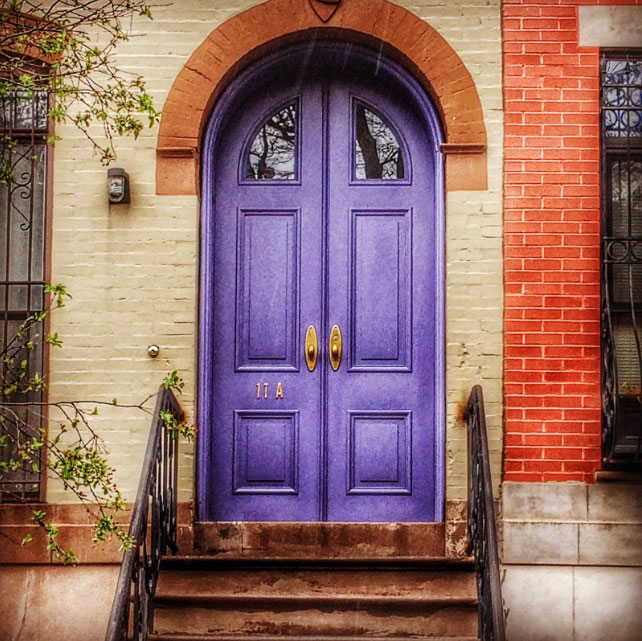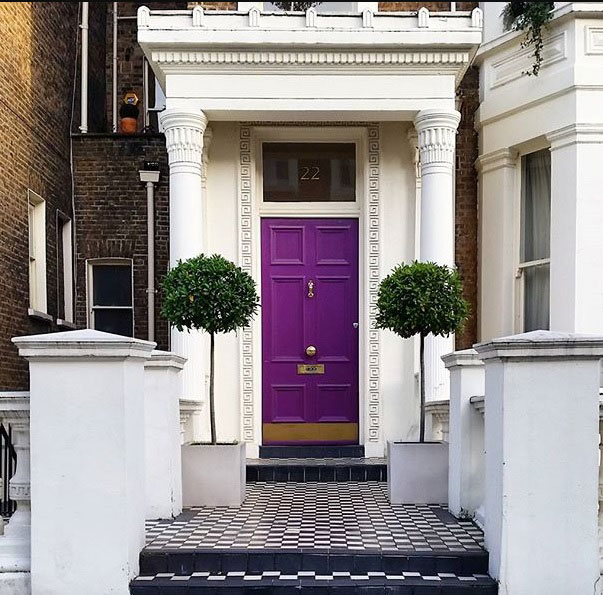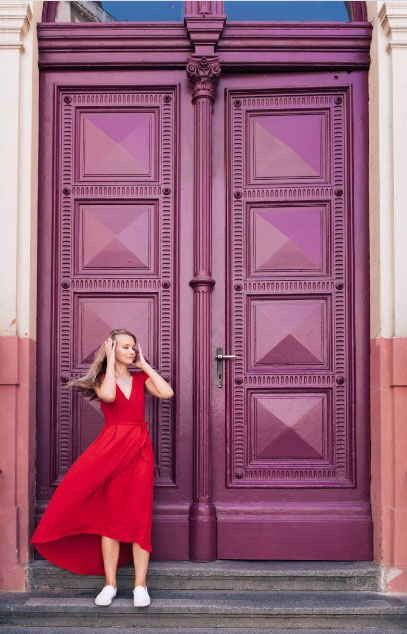A door is not just an entrance or exit to a building or room; it can also symbolize something deeper. In particular, the color of a door can hold significant meaning for those who understand its symbolism. And when it comes to purple doors, there are several interpretations that one can take. In this article with Impeccable Nest, we will explore the various meanings of a purple door and what it represents in different contexts.

What Does a Purple Door Mean?
A purple door can signify different things depending on the individuals who chose it. Here are some of the common meanings associated with purple doors:
Royalty and Luxury
The color purple has been historically associated with royalty, nobility, and power. It was a rare and expensive dye to produce in ancient times, and only the wealthiest members of society could afford it. This led to its use as a symbol of prestige and status throughout history.
The meaning of a purple door can vary depending on cultural and personal associations. In general, a purple front door is considered to be a bold choice that conveys a sense of luxury and elegance. It can also suggest that the inhabitants of the house are sophisticated and high-status, or that they value artistic expression and creativity.
From a psychological perspective, the color purple is often associated with imagination, spirituality, and introspection. It can inspire feelings of calmness, balance, and harmony, making it a popular choice for meditation spaces and relaxation areas. A purple door may therefore suggest that the homeowners prioritize self-reflection and tranquility in their daily lives.

In feng shui, the ancient Chinese practice of arranging living spaces to promote health and well-being, a purple front door is believed to attract abundance and prosperity. According to feng shui principles, the color purple represents wealth, success, and ambition, and can create a favorable energy flow into the home.
Overall, a purple door can symbolize many different things, from status and wealth to creativity and spiritual growth. Whether you choose to paint your front door purple for its aesthetic appeal or its deeper meanings, it is sure to make a bold and memorable statement.
Spirituality and Mysticism
The color purple has been used throughout history as a symbol of spirituality, mysticism and higher consciousness. It is often associated with royalty, luxury, and power due to its rarity in nature and the difficulty of producing the dye. However, when it comes to spiritual symbolism, purple takes on a much deeper meaning.
In many cultures, purple is considered to be a sacred color that represents the divine and the connection between the physical realm and the spiritual realm. It is also often associated with meditation, introspection and inner wisdom. In Hinduism, for example, the god Vishnu is often depicted with a purple complexion, representing his transcendent nature.
In terms of chakra theory, purple is the color of the third eye chakra, which is located in the center of the forehead and is responsible for intuition, insight, and perception beyond the physical realm. This chakra is believed to be the seat of inner wisdom and spiritual awareness, and is associated with heightened states of consciousness.
A purple door, then, can be seen as a symbol of spiritual awakening, inner peace, and connection to the divine. It may represent a portal or gateway to higher consciousness, inviting us to explore the mysteries of the universe and tap into our own inner wisdom. It may also serve as a reminder to stay open to new experiences and perspectives, and to trust our intuition as we navigate the world around us.
Creativity and Individuality
When it comes to home décor, a purple door can be a symbol of the homeowner’s creative and imaginative spirit. It may suggest that they are not afraid to take risks and try new things, both in their personal life and in their home design choices. It can also be interpreted as a sign of open-mindedness and willingness to embrace unconventional ideas, which can create a welcoming atmosphere for visitors.
Furthermore, the color purple has also been linked to royalty and luxury, as it was once considered a rare and expensive color to produce. A purple door can add a touch of elegance and sophistication to a home’s exterior, giving it a regal and refined look. This can be particularly effective when paired with complementary colors, such as gold or silver accents.
Wisdom and Knowledge
The color purple has long been associated with various symbolic meanings, including royalty, luxury, spirituality, and creativity. However, it also has connotations of wisdom, knowledge, and intellectualism.
In many cultures, purple is considered the color of scholars, philosophers, and teachers who strive to expand their minds and understand the world around them. It represents a quest for knowledge, enlightenment, and insight, as well as an appreciation for the power of ideas and critical thinking.

Therefore, a purple door can suggest that the occupants of the house value education, learning, and intellectual pursuits. It may indicate that they are intellectuals, academics, or otherwise interested in broadening their understanding of the world. They may be avid readers, thinkers, and conversationalists who enjoy engaging with complex ideas and exploring new concepts.
Beyond its symbolic associations, a purple door can also have aesthetic appeal. Depending on the shade and style of the door, it can add a touch of elegance, sophistication, or whimsy to a home’s facade. It may stand out from the surrounding buildings, drawing attention and creating a unique statement.
Examples of How a Purple Door Meanings
While the overarching meanings of purple doors are relatively consistent, the specific interpretation can vary based on the context. Here are a few examples of how a purple door might be interpreted:
On a house
The color of a front door can say a lot about the personality and characteristics of the homeowner. The choice of a purple front door, in particular, can convey a sense of confidence, boldness, and willingness to stand out from the crowd.
Purple is a unique color that often symbolizes creativity, luxury, and individuality. It is not a common color for front doors, which is why it stands out and attracts attention. Choosing a purple door suggests that the homeowner is not afraid to take risks and make bold choices, even if they might not be conventional or traditional.
Furthermore, the color purple has historically been associated with royalty and nobility. Painting a front door this color can therefore suggest that the homeowner values quality and luxury and wishes to create an air of sophistication around their home.
In a spiritual setting
A purple door in a church or temple holds significant symbolism and can represent a variety of meanings. Purple is a color that has long been associated with royalty, luxury, power, and spirituality. In religious contexts, purple is often used to symbolize the divine, the mystical, or the sacred.
In Christianity, purple is a liturgical color that is primarily associated with Lent, Advent, and other periods of preparation and reflection. The color is also used during certain feast days and celebrations, such as the Feast of the Epiphany. In this context, a purple door may represent a portal to a space that is reserved for contemplation, prayer, and worship. It may indicate that the space beyond the door is dedicated to the highest spiritual pursuits and is meant to be experienced with a sense of reverence and awe.
In Buddhism, purple holds similar significance. It is often used to represent wisdom, compassion, and the highest levels of consciousness. A purple door in a Buddhist temple may signify the entrance to a meditation hall or shrine room, where practitioners can engage in spiritual practices and connect with their inner selves. The door may also suggest that the space beyond is sacred and should be approached with deep respect and humility.
Overall, a purple door in a church or temple serves as a reminder of the importance of spirituality and the need to cultivate a connection with the divine. It symbolizes the sacredness of the space beyond and encourages visitors to approach it with a sense of reverence and wonder. Whether one is a devout practitioner or simply seeking a moment of quiet reflection, a purple door can serve as an invitation to enter into a deeper dimension of experience and understanding.
In a business setting
A purple door at an office or store can carry a variety of meanings and connotations depending on the context. However, one common interpretation is that it suggests creativity, innovation, and non-traditional thinking.
The color purple has long been associated with creativity and imagination, as well as spirituality and wisdom. It is a blend of blue (which represents stability and calmness) and red (which symbolizes energy and passion). When these two colors are combined to create purple, it can represent a balance between these opposing forces, resulting in a harmonious blend of both stability and energy.
In the context of a business, a purple door may suggest that those behind it are innovative and willing to take risks. It could signify that the company values creativity and is always looking for new and unique ideas to stay ahead of the competition. This could be particularly true for businesses that are related to industries such as design, marketing, or technology, where creativity and innovation are highly valued.
Furthermore, a purple door at an office or store may also indicate that the business is not afraid to challenge traditional ways of thinking. It may suggest that the company is open-minded and willing to explore alternative approaches to problem-solving. By choosing a non-traditional color such as purple for their door, the business is signaling that they are not bound by conventional norms and are willing to think outside the box.
In a personal setting
A purple door in a bedroom or art studio can carry a variety of meanings, but one of the most common interpretations is that it symbolizes a space for creativity and self-expression. Purple is often associated with imagination, inspiration, and intuition, making it a fitting choice for a doorway that leads to a room where art is made or ideas are explored.
The color purple also has deep spiritual symbolism in many cultures. In ancient Rome, purple was the color of royalty and power, while in medieval Europe, it was associated with spirituality and mysticism. In Hinduism and Buddhism, purple represents the crown chakra, which is associated with higher consciousness and enlightenment.
When applied to a door, the color purple can evoke a sense of mystery and intrigue. It suggests that there is something special behind the door, something that is not immediately visible or accessible to everyone. This can be especially true if the purple door is set against a contrasting backdrop, such as a white or neutral-colored wall.
At the same time, a purple door can also suggest a sense of privacy and introspection. The color purple is often associated with meditation and reflection, and so a purple door may indicate that the space beyond it is meant for quiet contemplation or personal growth. This can be particularly meaningful in a bedroom or art studio, where individuals often go to find solace and inspiration.
Ultimately, the meaning of a purple door will depend on the context in which it appears. While it may suggest creativity, spirituality, and introspection in one setting, it could have an entirely different connotation in another. Nevertheless, the color purple remains a rich and evocative symbol that can add depth and meaning to any space.
The Best Places to Use a Purple Door
While a purple door can suit different buildings and styles, some places can benefit more from this color choice. Here are some examples:
Victorian or Gothic-style houses
When it comes to selecting a color for your front door, purple may not be the first choice that comes to mind. However, if you own a Victorian or Gothic-style house, a purple door can be an excellent choice that adds a touch of elegance and sophistication to your home’s exterior.
Victorian-style homes are known for their ornate details and historical significance, which makes them perfect candidates for a purple door. The color purple is often associated with royalty and luxury, which complements the grandeur of these types of houses. Whether your Victorian home has intricate woodwork, stained glass windows, or embellished porch railings, a purple door can enhance these features and create a cohesive and eye-catching look.
Similarly, Gothic-style homes feature dramatic arches, pointed towers, and intricate stonework. These homes were designed to evoke a sense of mystery and appeal to the romanticism of the era, making them ideal candidates for a purple door. A purple front door can add to the dramatic flair of a Gothic-style house and make it stand out from neighboring homes.
Moreover, purple is a versatile color that can complement a range of other colors and styles. It pairs well with neutral colors like white, gray, and black, as well as brighter hues like yellow, green, and orange. This means that you can use a purple door to create a unique and personalized look that reflects your personal style and complements your home’s existing color scheme.
In conclusion, if you have a Victorian or Gothic-style house, a purple door can be an excellent way to enhance its historical significance and ornate details. Additionally, this color can help your home stand out and create a memorable impression on visitors and passersby alike.
Art galleries or museums
When it comes to choosing the right color for a door, there are many factors to consider such as the style of the building, the surrounding environment, and the purpose of the space behind the door. One color that can be an excellent choice for certain settings is purple. Purple is often associated with creativity, imagination, and inspiration, which makes it a popular color in art and culture. Therefore, one of the best places to use a purple door is in art galleries or museums.
Art galleries and museums are places where people go to appreciate and explore art and culture. These institutions often have a unique atmosphere and ambiance that can be enhanced by the use of color. A purple door can reflect the artistic and creative themes of these spaces and create a memorable image for visitors. The color purple can evoke feelings of creativity, passion, and sophistication, which can be perfect for these types of environments.
Additionally, purple can be an excellent choice for doors in museums or galleries that focus on specific art movements or styles, such as modern or contemporary art. These styles often incorporate bold colors and abstract shapes, and a purple door can complement these elements while also making a statement on its own.
Moreover, a purple door can serve as a visual cue to guide visitors through the space. In large museums or galleries, getting lost or disoriented is not uncommon. Using a brightly colored door can help guide visitors to different sections or exhibits, making it easier for them to navigate the space.
In conclusion, the best places to use a purple door are institutions that celebrate art and creativity such as art galleries and museums. A purple door can enhance the atmosphere of these spaces, incorporate the themes of the artwork, and provide a visual cue to guide visitors. Ultimately, using a purple door can create a memorable experience for visitors and make a lasting impression on those who enter.
Yoga studios or meditation centers
Yoga studios and meditation centers are perfect places to use a purple door as it aligns with the spiritual and transformative goals of these practices, creating a calming atmosphere that encourages relaxation and focus. The color purple is often associated with spirituality, intuition, and inner wisdom, making it an ideal choice for places where people go to connect with their inner selves.
In yoga and meditation practices, the goal is to find inner peace, balance, and tranquility. Purple is believed to have a calming effect on the mind and body, reducing stress and anxiety levels. It is also associated with creativity and imagination, which can help practitioners tap into their creative side while they engage in these practices.
The use of a purple door in yoga and meditation studios can also signal that the space is dedicated to promoting spiritual growth and healing. This can create a sense of reverence and respect among the practitioners, enhancing their experience and deepening their connection to the practice.
Additionally, purple is known to be a color that stimulates the third eye chakra, which is responsible for intuition and insight. By having a purple door, practitioners may feel more connected to this aspect of themselves, allowing them to access deeper insights and understandings during their practice.
Overall, using a purple door in yoga studios or meditation centers can be a powerful tool for enhancing the practitioner’s experience. It creates a calming atmosphere, promotes creativity and intuition, and signals a commitment to spiritual growth and healing.
Music venues or theaters
If you’re looking to make a bold statement with your entrance, using a purple door can be a great choice. While purple may not be the first color that comes to mind for a front door, it can work especially well in certain settings. One of the best places to use a purple door is in music venues or theaters.
In these spaces, purple can evoke the dramatic and entertaining aspect of the environment. Music venues and theaters are often associated with excitement, energy, and creativity, and a purple door can help to reinforce those associations. Additionally, purple is known for its ability to attract attention, so a purple door can help to draw people in from afar.
When choosing a shade of purple for your door, there are a few things to consider. Darker, richer shades of purple can create a sense of elegance and sophistication, while lighter shades can feel more playful and whimsical. Depending on the overall aesthetic of your venue or theater, you may want to choose a specific shade of purple that complements the other colors and decor elements.
Of course, the color of your door is just one aspect of creating an inviting entrance. It’s also important to ensure that the door itself is in good condition and that the surrounding area is clean and well-maintained. Adding decorative touches like plants or lighting can also help to enhance the overall effect.
In summary, if you’re looking for a way to make your music venue or theater stand out, using a purple door can be a smart choice. Purple can evoke the drama and entertainment of these spaces, and can help to attract attention from afar. Just be sure to choose the right shade of purple to complement your overall aesthetic, and take care to maintain the door and its surroundings.
Conclusion
A purple door can be much more than a simple entryway; it can be a statement of personality, style, and beliefs. Whether you choose a pale lavender or a deep plum, a purple door can add a touch of elegance, mystery, or spirituality to your home or business. By understanding the symbolism and meaning behind the color, you can create a door that reflects your values, goals, and aspirations, and invites positive energy into your life.
In conclusion, the purple door meaning can vary depending on culture, context, and personal interpretation. However, some common associations with the color include royalty, spirituality, creativity, and wisdom. A purple door can enhance the curb appeal of a house or business, add a unique touch to the exterior, and serve as a symbol of values and goals.
When choosing a purple door, consider factors such as the shade, the surrounding colors and materials, the decorative elements, and the maintenance. A well-chosen and well-maintained purple door can make a lasting impression on visitors and provide a source of inspiration and motivation for the occupants.
Whether you’re remodeling your home or designing a new one, don’t overlook the power of a colorful and meaningful front door. A purple door can be an expression of your personality, style, and aspirations, and a way to welcome positive energy into your life.

Hey there! I am Salena Snyde, a dream psychologist with over 10 years of experience. I am the primary author of the Dream Meanings section on Impeccable Nest, where I not only share in-depth knowledge about the nature, function, and significance of dreams but also connect with readers through profound articles and quality information. With passion and a diverse knowledge of dreams, I have established strong connections with dream experts worldwide by reading articles and studying leading books on the subject. I believe that the combination of personal insights and sharing from the dream expert community can provide the most profound and comprehensive understanding for everyone.
